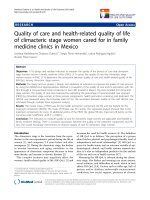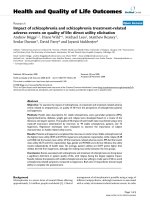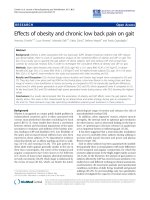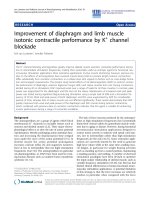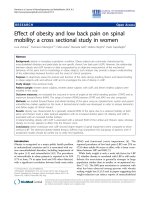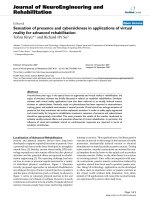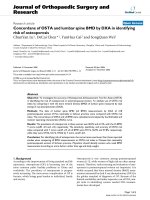Báo cáo hóa học: " Department of Electrical and Computer Engineering, " pot
Bạn đang xem bản rút gọn của tài liệu. Xem và tải ngay bản đầy đủ của tài liệu tại đây (655.65 KB, 3 trang )
EURASIP Journal on Wireless Communications and Networking 2004:1, 1–3
c
2004 Hindawi Publishing Corporation
Editorial
Jitendra K. Tugnait
Department of Electrical and Computer Engineering, Auburn University, Auburn, AL 36849-S201, USA
Email: tugnait@e n g.auburn.edu
Hui Liu
Department of Electrical Engineering, University of Washington, Seattle, WA 98195-2500, USA
Email:
Guang Gong
Department of Electrical and Computer Engineering, University of Waterloo, Waterloo, Ontario, Canada N2L 3G1
Email:
Tongtong Li
Department of Electrical and Computer Engineering, Michigan State University, East Lansing, MI 48824-1226, USA
Email:
This editorial reflects the emerging system design and
signal detection methods for next-generation digital cellular
CDMA system. In CDMA system, in addition to intersymbol
interference (ISI) caused by multipath propagation, simul-
taneous transmission also introduces multiuser interference
(MUI). The receiver is, therefore, required to separate and
recover the information signal of the desired user(s). Com-
pared to the conventional single-user detectors where inter-
fering users are modeled as noise, significant improvement
can be obtained with multiuser detectors where MUI is ex-
plicitly part of the signal model.
In literature, if the spreading sequences are periodic and
repeat every information symbol, the system is referred to as
short-code CDMA, and if the spreading sequences are aperi-
odic or essentially pseudo-random, it is known as long-code
CDMA. Since multiuser detection relies on the cyclostation-
arity of the received signal, which is significantly complicated
by the time-varying modeling of the long-code system, re-
search on blind multiuser detection has largely been limited
to short-code CDMA. On the other hand, long-code is widely
used in virtually all operational and commercially proposed
CDMA systems due to its performance stability in frequency
fading environment and better information security. More
recently, researchers have been targeting on effective and ef-
ficient multiuser detectors for long-code CDMA systems as
well. Furthermore, combination of CDMA and OFDM is at-
tracting more and more attention in order to take the advan-
tages of both schemes.
In this special issue, novel techniques on spreading se-
quences design, space diversity (multiple transmit and re-
ceive antennas), time diversity (channel coding, interleav-
ing), and combination of CDMA and OFDM, in conjunc-
tion with new channel estimation and signal extraction ap-
proaches, are intensively investigated to achieve good system
performance while improving system capacity for broadband
multimedia wireless communications.
This special issue contains the following five topics.
Spreading sequence design
Spreading sequence design is essential in synchronization,
channel estimation, effective MUI suppression, and commu-
nication security. On this topic, (i) Cotae addresses the prob-
lem for an overloaded synchronous DS-CDMA system in a
multicell environment. A promising algorithm has been de-
rived to design orthogonal generalized WBE sequence sets
for any processing gain. (ii) Ren proposes an efficient and
flexible approach to construct pseudo-random sequences
with long period, large complexity, balance statistics, and low
correlation properties from addition of M-sequences with
pairwise-prime linear spans. (iii) Fan gives a nice survey on
the recent trends and results on generalized orthogonal and
quasiorthogonal sequences design and theoretical limits.
Space-time signal processing
As a relatively new member in space-time signal processing,
transmit antenna diversity is gaining increasing popularity
2 EURASIP Journal on Wireless Communications and Networking
in communication system design and signal extraction. On
this topic, (i) Dai, Mailaender, and Poor study the algorithm
choice in CDMA cellular downlink transmission with trans-
mit antenna arrays over multipath fading channels. They
conclude that, in general, maximum SNR beamforming is
the best choice for circuit-switched systems, whereas for
packet-switched systems, maximum SINR beamforming is
the best choice. (ii) W. Li and Gulliver introduce a novel
successive interference cancellation (SIC) technique for DS-
CDMA systems employing space-time block codes (STBC)
at the transmit side. Both hard- and soft-decision-based c an-
cellation schemes are analyzed and simulated.
Multicarrier CDMA
Due to its strong capability in combating frequency-selective
fading and tracking the time-varying channels, multicarrier
CDMA (MC-CDMA), which is the combination of CDMA
and OFDM, is a promising candidate for broadband com-
munication systems. On this topic, (i) Rahman, Sesay, and
Hefnawi consider a two-stage ML-based detector for a mul-
titone CDMA system. In the first stage, the channel is esti-
mated using a given symbol, while in the second stage, the es-
timated channel is used to detect the next symbol. The theo-
retical model is validated with simulation results for Rayleigh
fading environments. (ii) Preequalization techniques are de-
rived by Silva and Gameiro for downlink TDD MC-CDMA
system using space-frequency algorithms. The approaches ef-
fectively reduce multiple access interference at the base sta-
tion, enabling low-cost terminal designs without sacrificing
the system performance. (iii) Raulefs, Dammann, Sand, and
Kaiser present an innovative rotated Walsh-Hadamard-based
spreading scheme for MCCDMA applications. The rotated
spread gain, stemmed from s ignal-space diversity, increases
the system performance by almost 1 dB in a fading environ-
ment.
Channel estimation and signal detection
Accurate channel estimation is the guarantee for effective
signal detection. On this topic, novel blind channel estima-
tion and multiuser detection approaches are investigated for
long-code CDMA and MC-CDMA systems. More specifi-
cally, (i) Sirbu and Koivunen address the problem of prop-
agation delay estimation in asynchronous long-code DS-
CDMA multiuser systems. By modeling the users’ propaga-
tion delays in the MIMO channel matrix, delay estimates are
obtained as a by-product of the channel estimation. (ii) P.
Liu and Xu carry out a joint performance study of chan-
nel estimation and multiuser detection for long-code up-
link CDMA systems using perturbation theory. Simulation
and analytical results show good agreement. (iii) Dang and
van der Veen present a joint multiuser source-channel esti-
mation approach for long-code CDMA, which is the com-
bination of the blind (decorrelating) RAKE receiver with
an iterative symbol/channel estimation algorithm. The algo-
rithm shows a significant improvement over the decorrelat-
ing RAKE receiver and the conventional RAKE receiver. (iv)
Gelli, Paura, and Verde propose a novel two-stage blind mul-
tiuser detector for quasisynchronous MC-CDMA systems.
The receive filter is factored into the production of two parts:
f = F u, and each part is optimized accordingly. u is calcu-
lated based on the constant modulus criterion, and F serves
as the constraint so that the system will extract the desired
user.
System design and signal processing
On this topic, the researchers explore innovative transmit-
ter and receiver design for CDMA systems. (i) Hou, Yi,
and Lee propose an intriguing multilevel coding scheme
based on LDPC to facilitate multimedia applications in
future-generation wireless networks. By offering one low-
rate channel and two high-r ate channels, the new method
allows simultaneous transmission of voice and greater than
1 Mbps high-speed data with minimum error and latency.
(ii) Madhukumar, Chin, Liang, and Yang propose a single-
carrier cyclic prefix-assisted CDMA system with frequency
domain equalization. The proposed system has the advan-
tages of conventional MC-CDMA system, but does not
suffer from the high peak-to-average ratio and sensitiv-
ity to frequency offset and phase noise. (iii) Vanhaver-
beke and Moeneclaey consider to improve the performance
of overloaded CDMA systems. The main idea is to intro-
duce time shifts between users so that the overall MUI
power is minimized. Simulation results demonstrate the ef-
fectiveness of the proposed approach. (iv) Park, Lim, and
Gelfand present a performance study showing that with a
low-complexity MMSE multiuser detector, superior perfor-
mance can be obtained through coding across multicodes
and time.
We thank all the authors who submitted their articles to
the special issue. Special thanks go to all the reviewers for
their hard work, on which the quality of the special issue
relies. Last but not least, thanks to the Editor-in-Chief and
the Editorial Board of EURASIP JWCN for their support and
thanks to Hindawi Publishing Corporation for making the
publication of this special issue possible.
Jitendra K. Tu gnait
Hui Liu
Guang Gong
Tongtong Li
Jitendra K. Tugnait received the B.S. degree
(with honors) in electronics and electrical
communication engineering from the Pun-
jab Engineering College, Chandigarh, India,
in 1971, the M.S. and the E.E. degrees from
Syracuse University, Syracuse, NY, and the
Ph.D. degree from the University of Illinois,
Urbana-Champaign, in 1973, 1974, and
1978, respectively, all in electrical engineer-
ing. From 1978 to 1982, he was an Assistant
Professor of electrical and computer engineering at the University
of Iowa, Iowa City, Iowa. He was with the Long Range Research
Division, the Exxon Production Research Company, Houston, Tex,
Editorial 3
from June 1982 to September 1989. He joined the Department of
Electrical & Computer Engineering, Auburn University, Auburn,
Ala, in September 1989 as a Professor. He currently holds the title
of James B. Davis and Alumni Professor. His current research in-
terests are in statistical signal processing, wireless and wireline dig-
ital communications, and stochastic systems analysis. Dr. Tugnait
is a past Associate Editor of the IEEE Transactions on Automatic
Control and of the IEEE Transactions on Signal Processing. He is
currently an Editor of the IEEE Transactions on Wireless Commu-
nications. He was elected Fellow of IEEE in 1994.
Hui Liu received a B.S. in 1988 from Fu-
dan University, China, an M.S. in 1992 from
Portland State University, and a Ph.D. de-
gree in 1995 from the University of Texas at
Austin, all in electrical engineering. He held
the position of assistant professor at the De-
partment of Electrical Engineering at Uni-
versity of Virginia from September 1995 to
July 1998. Dr. Liu was the chief scientist at
Cwill Telecommunications, Inc., and one of
the principal designers of the TD-SCDMA system. Dr. Liu is cur-
rently an associate professor at the Department of Electrical En-
gineering, University of Washington, Seattle. His research inter-
ests include broadband wireless networks, array signal processing,
and multimedia signal processing. He has published more than 35
journal articles and has twelve awarded or pending patents. He is
the author of Signal Processing Applications in CDMA Communica-
tions, Artech House. Dr. Liu’s activities for the IEEE Communica-
tions Society include membership on several technical committees
and serving as an editor for the IEEE Transactions in Communica-
tions. He is the elected General Chairman for the 2005 Asilomar
Conference on Signals, Systems, and Computers. He is a recipi-
ent of 1997 National Science Foundation CAREER Award, The Best
Patent Award in China, and 2000 Office of Naval Research Young
Investigator Award.
Guang Gong received the B.S. degree in
mathematics in 1981, the M.S. degree in ap-
plied mathematics in 1985, and the Ph.D.
degree in electrical engineering in 1990
from universities in China. She received
the postdoctoral fellowship from the Fon-
dazione Ugo Bordoni, Rome, Italy, and
spent the following year there. After her re-
turn from Italy, she was promoted to As-
sociate Professor at the University of Elec-
trical Science and Technology of China.
Since 1995, she has worked with several internationally recog-
nized outstanding coding experts and cryptographers including Dr.
Solomon W. Golomb at the University of Southern California, Los
Angeles, USA. She joined the Department of Electrical and Com-
puter Engineering, University of Waterloo, Ontario, Canada, in
September 2000. Currently, she is an Associate Professor. Her re-
search interests are in the area of sequence design, cryptography,
and communications security. She also holds a cross-appointment
in the Department of Combinatorics and Optimization, Univer-
sity of Waterloo. Dr. Gong has received several awards including
the Best Paper Award from the Chinese Institute of Electronics in
1984, Outstanding Doctorate Faculty Award of Sichuan Province,
China, in 1991, and the Premier’s Research Excellence Award, On-
tario, Canada, in 2001.
Tongtong Li got her Ph.D. degree in electri-
cal engineering in 2000 from Auburn Uni-
versity. From 2000 to 2002, she was with Bell
Labs, and had been working on the design
and implementation of wireless commu-
nication systems, including 3GPP UMTS
and IEEE 802.11a. She joined the faculty of
Michigan State University in 2002, and is
currently an Assistant Professor in the De-
partment of Electrical and Computer Engi-
neering (ECE) at Michigan State University. Her research interests
fall into the areas of wireless and wirelined communication sys-
tems, multiuser detection and separation over time-varying wire-
less channels, wireless networking and network security, and digi-
tal signal processing with applications in wireless communications.
She is serving as an Editorial Board Member for EURASIP Journal
on Wireless Communications and Networking.

